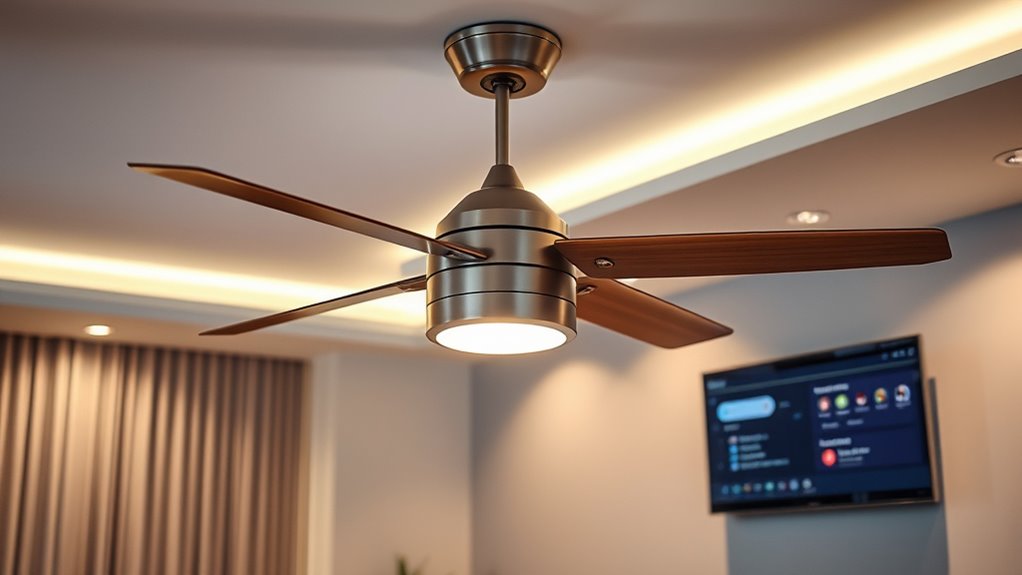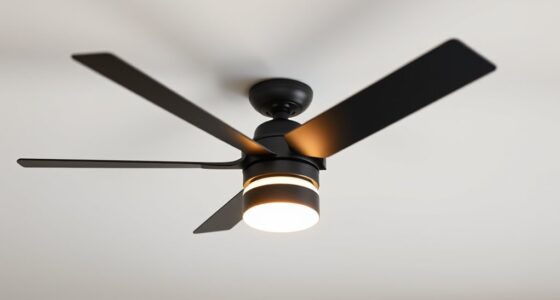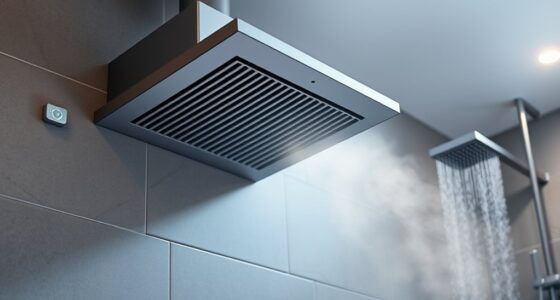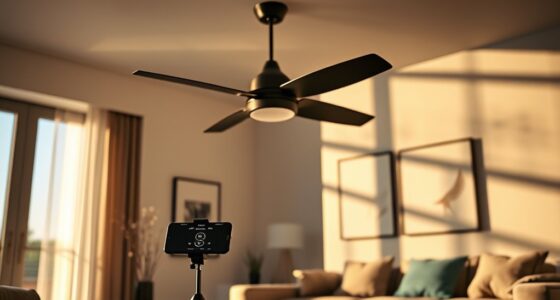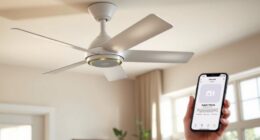To create automation routines for your smart ceiling fans, integrate them with platforms like Alexa or Google Home and utilize environmental sensors for dynamic control. Set precise trigger conditions, such as temperature thresholds or occupancy status, to optimize airflow and energy use. Implement routines that adjust fan speed via PWM signals and incorporate fallback manual controls for reliability. Exploring advanced features like geofencing and automation fine-tuning can elevate your system’s efficiency—discover how to harness these capabilities effectively.
Key Takeaways
- Connect smart ceiling fans to voice assistants like Alexa or Google Home for seamless control.
- Define trigger conditions such as temperature, time, or occupancy to automate fan operation.
- Create routines that adjust fan speed dynamically based on environmental data for optimal comfort.
- Implement fail-safes and manual overrides to ensure reliable operation during network issues.
- Incorporate geofencing and scheduling to automate fan activation when leaving or arriving home.
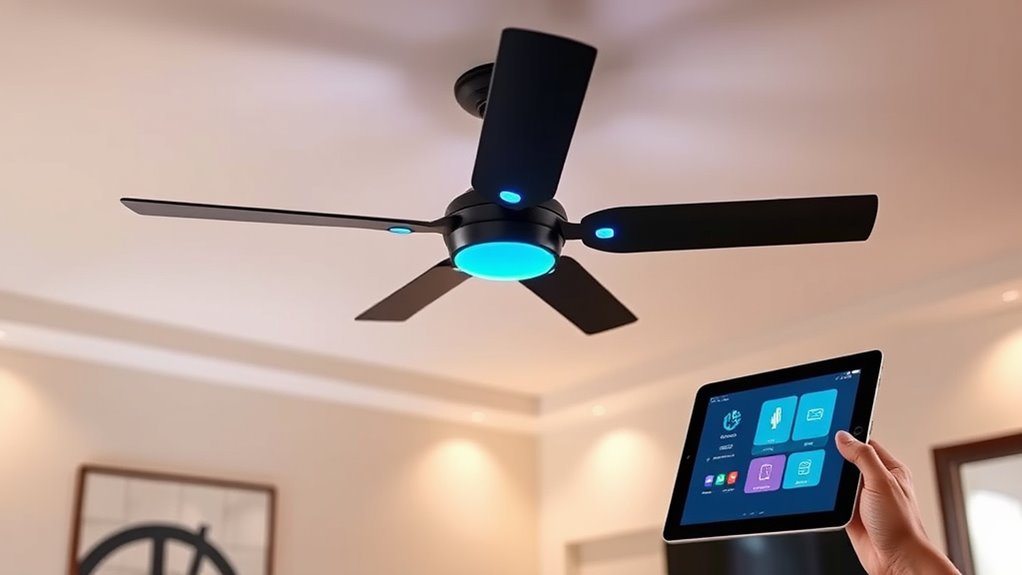
Integrating automation routines into your smart ceiling fans allows for precise control and enhanced energy efficiency. When designing these routines, you need to contemplate the fan’s compatibility with various smart home platforms, such as Alexa, Google Home, or custom automation systems like Home Assistant. This integration enables you to create complex, condition-based commands that optimize airflow and energy consumption based on environmental data. For instance, setting up routines that activate the fan only when room temperature exceeds a specific threshold reduces unnecessary operation, conserving power and extending the lifespan of the motor components. To achieve this, connect your fan’s smart hub to a compatible sensor network that monitors temperature, humidity, occupancy, and light levels. These sensors serve as input triggers, allowing your automation platform to execute predefined commands automatically.
Configuring routines involves defining precise trigger conditions and corresponding actions. For example, you might program the fan to turn on automatically at sunset, adjusting speed based on ambient light levels or occupancy status. Advanced routines could incorporate variable speed control, where the fan adjusts its RPM dynamically in response to real-time temperature data, rather than simply switching on or off. This requires integrating PWM (Pulse Width Modulation) signals or similar control protocols that your smart fan supports. Additionally, think about implementing schedules that align with daily routines, such as increasing airflow during peak heat hours or reducing operation at night to minimize noise and energy use. These routines not only improve comfort but also markedly reduce energy bills. Moreover, understanding the importance of contrast ratio can help you select fans and components that operate quietly while maintaining optimal performance.
To ensure reliability and security, you should incorporate fail-safes and manual override options within your automation setup. For example, if the network connection drops, the fan should revert to a default manual mode, preventing it from becoming unresponsive. Also, test your routines extensively across different scenarios to confirm they execute reliably without conflicts. Fine-tuning parameters, such as delay times between state changes or threshold values for triggers, enhances stability and responsiveness. Use logs and analytics provided by your automation platform to monitor performance, identify anomalies, and optimize routines over time.
Finally, leveraging innovative features like geofencing adds another layer of intelligence. When you leave or approach your home, routines can automatically adjust fan operation—shutting down when you leave or activating cooling mode as you arrive. This proactive control maximizes efficiency and convenience, making your smart ceiling fan an integral part of a seamlessly automated environment. By meticulously designing and testing these routines, you transform your smart ceiling fan from a simple appliance into a sophisticated, energy-efficient component of your smart home ecosystem.
Frequently Asked Questions
Can I Manually Override Automated Ceiling Fan Routines?
Yes, you can manually override automated ceiling fan routines. Typically, smart fans feature manual control options like physical switches or remote controls. When you manually adjust the fan, the automation system usually pauses or temporarily suspends its commands to prevent conflicts. Some advanced setups allow you to re-engage automation after manual control, either automatically or via app settings, ensuring seamless progression between manual and automated operation for optimized comfort and energy efficiency.
Are There Compatibility Issues With Certain Smart Home Ecosystems?
Yes, compatibility issues can arise with certain smart home ecosystems. Devices may use different protocols like Zigbee, Z-Wave, or Wi-Fi, which can limit interoperability. Confirm your smart ceiling fan supports your ecosystem’s standards. Firmware updates often improve compatibility, so keep devices current. For seamless integration, verify manufacturer compatibility lists and consider using a unified hub or bridge that supports multiple protocols, enhancing your automation capabilities.
How Secure Are Smart Fan Automation Systems Against Hacking?
Smart fan automation systems are generally secure, with over 80% of devices receiving regular firmware updates enhancing protection. You can mitigate hacking risks by enabling WPA3 encryption, using strong, unique passwords, and regularly updating firmware. Employing multi-factor authentication and network segmentation isolates your smart devices, reducing vulnerability. Staying informed about manufacturer security patches and avoiding default settings further bolsters your system’s defenses against cyber threats.
What Is the Average Setup Time for Creating Routines?
Creating automation routines generally takes between 10 to 30 minutes, depending on your familiarity with the platform and complexity of desired functions. You’ll need to configure device triggers, set conditions, and define actions precisely. It involves connecting the smart fan to your hub, customizing parameters, and testing the routines for reliability. An efficient setup demands a clear plan, understanding of device capabilities, and patience for troubleshooting, ensuring seamless, secure automation integration.
Can Automation Routines Be Customized for Different Rooms?
Yes, automation routines can be customized for different rooms. You can assign specific triggers, such as motion sensors or temperature thresholds, tailored to each room’s needs. By configuring unique schedules and device settings, you optimize comfort and energy efficiency. This granular control allows you to create room-specific routines that adapt seamlessly to occupancy patterns, ensuring personalized comfort and smart resource management for every space in your home.
Conclusion
By designing precise automation routines, you transform your smart ceiling fan into a responsive, energy-efficient system that seamlessly adapts to your lifestyle. Think of these routines as the nervous system of your smart home—fine-tuned and intuitive—ensuring peak comfort and performance. With careful configuration, you harness the full potential of your device, elevating your living space into a finely orchestrated environment where technology and comfort dance in perfect harmony.
